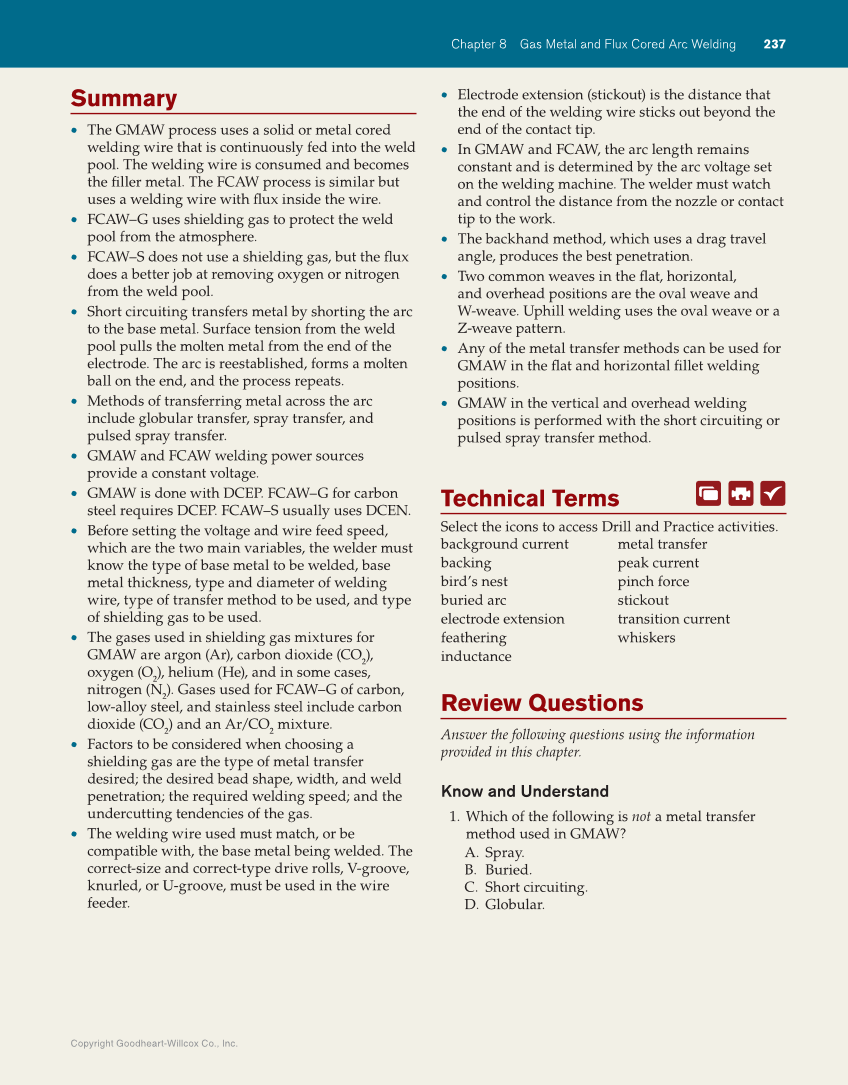Copyright Goodheart-Willcox Co., Inc. Chapter 8 Gas Metal and Flux Cored Arc Welding 237 Summary „ The GMAW process uses a solid or metal cored welding wire that is continuously fed into the weld pool. The welding wire is consumed and becomes the filler metal. The FCAW process is similar but uses a welding wire with flux inside the wire. „ FCAW–G uses shielding gas to protect the weld pool from the atmosphere. „ FCAW–S does not use a shielding gas, but the flux does a better job at removing oxygen or nitrogen from the weld pool. „ Short circuiting transfers metal by shorting the arc to the base metal. Surface tension from the weld pool pulls the molten metal from the end of the electrode. The arc is reestablished, forms a molten ball on the end, and the process repeats. „ Methods of transferring metal across the arc include globular transfer, spray transfer, and pulsed spray transfer. „ GMAW and FCAW welding power sources provide a constant voltage. „ GMAW is done with DCEP. FCAW–G for carbon steel requires DCEP. FCAW–S usually uses DCEN. „ Before setting the voltage and wire feed speed, which are the two main variables, the welder must know the type of base metal to be welded, base metal thickness, type and diameter of welding wire, type of transfer method to be used, and type of shielding gas to be used. „ The gases used in shielding gas mixtures for GMAW are argon (Ar), carbon dioxide (CO 2 ), oxygen (O2), helium (He), and in some cases, nitrogen (N 2 ). Gases used for FCAW–G of carbon, low-alloy steel, and stainless steel include carbon dioxide (CO 2 ) and an Ar/CO 2 mixture. „ Factors to be considered when choosing a shielding gas are the type of metal transfer desired the desired bead shape, width, and weld penetration the required welding speed and the undercutting tendencies of the gas. „ The welding wire used must match, or be compatible with, the base metal being welded. The correct-size and correct-type drive rolls, V-groove, knurled, or U-groove, must be used in the wire feeder. „ Electrode extension (stickout) is the distance that the end of the welding wire sticks out beyond the end of the contact tip. „ In GMAW and FCAW, the arc length remains constant and is determined by the arc voltage set on the welding machine. The welder must watch and control the distance from the nozzle or contact tip to the work. „ The backhand method, which uses a drag travel angle, produces the best penetration. „ Two common weaves in the flat, horizontal, and overhead positions are the oval weave and W-weave. Uphill welding uses the oval weave or a Z-weave pattern. „ Any of the metal transfer methods can be used for GMAW in the flat and horizontal fillet welding positions. „ GMAW in the vertical and overhead welding positions is performed with the short circuiting or pulsed spray transfer method. Technical Terms background current backing bird’s nest buried arc electrode extension feathering inductance metal transfer peak current pinch force stickout transition current whiskers Review Questions Answer the following questions using the information provided in this chapter. Know and Understand 1. Which of the following is not a metal transfer method used in GMAW? A. Spray. B. Buried. C. Short circuiting. D. Globular. Select the icons to access Drill and Practice activities. Ch08.indd 237 7/11/2019 3:25:27 PM
